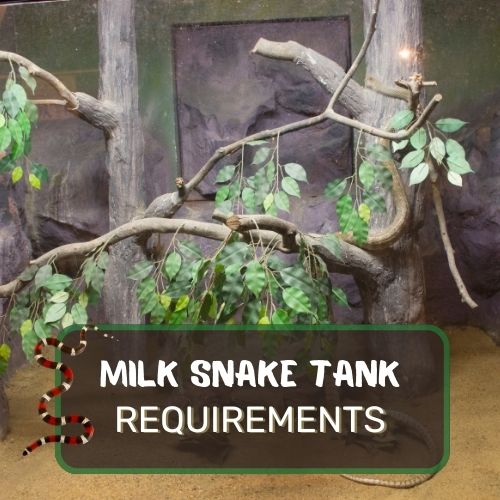Milk snakes, with their vibrant patterns and captivating behaviors, are a favorite among reptile enthusiasts. But what do these slithering wonders munch on, especially when in captivity?
Milk snakes in captivity primarily eat rodents, such as mice and baby rats. These serve as their staple diet. Occasionally, they might snack on insects like crickets or mealworms. Some species even relish bird eggs. It’s vital to replicate their natural diet to ensure their health and well-being.
This article delves deep into the dietary preferences of milk snakes, comparing their wild diet to what they’re fed in captivity. We’ll explore the importance of rodents, the occasional insect treat, and even the luxurious egg meal.
Plus, we’ll address the age-old debate of live vs. frozen-thawed prey and peek into the unique needs of young versus adult snakes. Buckle up for a culinary journey in the world of milk snakes!

Table of Contents
- 1 The Wild Diet of Milk Snakes: A Brief Glimpse
- 2 The Basics: Why Diet in Captivity Differs
- 3 Main Course: Rodents on the Menu
- 4 Milk Snakes & Insects: An Occasional Treat
- 5 Eggs: A Delicacy for Some Milk Snakes
- 6 Handling Live Prey: To Do or Not To Do?
- 7 Feeding Young vs. Adult Milk Snakes: Age Matters
- 8 Conclusion
- 9 FAQ
The Wild Diet of Milk Snakes: A Brief Glimpse
Picture this: A vibrant milk snake thriving in its natural woodland or meadow habitat. So, what’s on the menu for this captivating reptile in the wild?
What they munch on in their natural habitats
Milk snakes aren’t fussy eaters. Primarily, they feast on rodents like mice. Occasionally, their palate craves bird eggs, smaller reptiles, or even amphibians. They’re opportunistic hunters, seizing whatever their environment presents.
The role of diet in their ecosystem
But it’s not just about hunger. These snakes play a crucial role in their ecosystem. By regulating rodent and small creature populations, they maintain a balance. It’s like they’re nature’s very own pest control.
This dietary dance isn’t just about survival; it’s their contribution to the rhythm of nature. Understanding this wild diet gives insights into their needs in captivity.

The Basics: Why Diet in Captivity Differs
Ever wonder why, when it comes to our pets and animals in captivity, there’s always a special diet or a recommended feed? There’s a science to it, and it’s fascinating!
Difference between wild and captive environments
In the wild, nature is the master chef. The environment provides a smorgasbord of options, and predators, including our slinky friend the milk snake, choose based on availability and preference.
Wild environments also offer a range of stimuli: the thrill of the hunt, the unpredictability of prey, and the challenges of varied terrains.
But captivity? It’s a bit more predictable. The terrains are fixed, and there’s no real hunt – it’s more of a scheduled feeding time.
Importance of replicating natural diet in captivity
While we can’t recreate the wild’s vastness in captivity, what we can control is the diet. Ensuring that the diet closely mirrors what they’d get in their natural habitat is crucial for their health and well-being.
It’s about more than just filling their belly; it’s about providing the right nutrients, maintaining their natural instincts, and ensuring they’re mentally stimulated.
When we replicate their natural diet, we’re honoring their wild heritage and ensuring they thrive even in a captive setting.

Main Course: Rodents on the Menu
Alright, let’s talk about the main event: rodents. The pièce de résistance for any milk snake in captivity!
Importance of rodents in a captive milk snake’s diet
Rodents are to milk snakes what a juicy steak might be to us – essential and oh-so-satisfying. They provide a rich source of protein and are biologically appropriate, meeting the dietary needs of these reptiles perfectly.
But it’s not just about protein; it’s about the whole package – the bones, the fur, the organs – all these play a role in the milk snake’s nutrition.
Types of rodents: mice, baby rats, etc.
When it comes to variety, there’s no shortage in the rodent department. The most common choices for milk snakes include mice and baby rats. But why these specific rodents?
Well, their size makes them manageable prey for milk snakes, and they’re rich in the nutrients the snakes need. Each rodent type offers its unique set of benefits, ensuring the snake gets a well-rounded meal.
Frequency and size of feeding
Now, here’s where things get a tad technical. While in the wild, a milk snake might eat whenever it stumbles upon suitable prey, in captivity, there’s a schedule to adhere to.
Typically, young milk snakes should be fed every 5-7 days, while adults can go a bit longer, around 7-10 days. As for size? It’s generally recommended to feed them prey that’s about the same width as the widest part of the snake.
That ensures it’s manageable for them to swallow and digest.

Milk Snakes & Insects: An Occasional Treat
Insects. For us, they might just be those pesky bugs buzzing around during a warm summer evening, but for our milk snake buddies? It’s like getting served a plate of gourmet hors d’oeuvres!
Types of insects suitable for milk snakes
Milk snakes aren’t too picky when it comes to insects, but some are more suitable than others. Crickets are often a top pick, being readily available and easy to digest. Mealworms and waxworms are also on the list.
These insects provide a good mix of textures and flavors (if you could ask a snake, of course)!
Frequency of offering insects
Now, insects aren’t the main course but rather a special treat. Offering them once a week or every other week is a good frequency. Remember, you want to ensure that the majority of their diet remains rodent-centric, with insects playing a supplementary role.
Nutritional benefits
Why bother with insects at all? Well, they’re packed with nutrients! Insects can provide essential fatty acids, proteins, and some vital minerals.
They’re like the occasional superfood smoothie we might indulge in – a boost of nutrition to complement the primary diet.
Eggs: A Delicacy for Some Milk Snakes
Ever seen a snake enjoy an egg? It’s quite the spectacle, and for some milk snakes, it’s a culinary experience they relish.
Which species of milk snakes prefer eggs?
Not all milk snakes are egg enthusiasts, but some species, particularly the Eastern milk snakes (Lampropeltis triangulum triangulum), have been known to have a soft spot for bird eggs.
How to safely offer eggs in captivity
If you’re planning to introduce eggs to your milk snake’s diet, there are a few things to remember. Firstly, ensure the eggs are fresh and haven’t been treated with any chemicals. Quail eggs are a popular choice due to their small size.
Remember, the egg should be an appropriate size for your snake to handle and consume. Offer the egg in a shallow dish and let the snake decide when it’s brunch time!
Nutritional content and benefits
Eggs are nature’s multivitamin. They’re packed with protein, good fats, vitamins, and minerals. For milk snakes, they offer a nutritious change of pace from their regular rodent-based diet.
Eggs can help in providing a well-rounded diet, ensuring your snake gets a diverse range of nutrients.

Handling Live Prey: To Do or Not To Do?
When it comes to feeding milk snakes in captivity, one of the most hotly debated topics is whether to offer live prey or go the frozen-thawed route. It’s like the great pineapple on pizza debate, but for reptile enthusiasts!
The debate over live vs. frozen-thawed prey
Some purists argue that live prey stimulates the snake’s natural hunting instincts, making their captive life feel a tad more “wild.”
On the other side of the spectrum, many experts advocate for frozen-thawed prey, citing various benefits that we’ll delve into shortly.
Pros of Live Prey:
- Pros: Activates natural hunting behavior, fresher in terms of nutrition.
- Cons: Can pose a risk to the snake if the prey fights back (especially rodents with sharp teeth), ethical concerns about live feeding, and more maintenance as you need to care for live animals.
Cons of Frozen-thawed Prey:
- Pros: Safer for the snake, more convenient for the keeper, ethically more accepted, and long storage life.
- Cons: Might be less stimulating for the snake, needs proper thawing before feeding.
Safety precautions when offering live prey
If you decide to go the live prey route, always be vigilant. Monitor the feeding closely to ensure the prey doesn’t harm your snake.
Using feeding tongs can also help maintain a safe distance. It’s crucial never to leave live prey unattended with your snake.

Feeding Young vs. Adult Milk Snakes: Age Matters
Just like humans, the dietary needs of milk snakes change as they grow. A baby snake isn’t just a mini-version of its adult counterpart; it has different nutritional requirements!
Differences in dietary needs based on age
Young milk snakes are growing rapidly, so they need a more frequent influx of nutrients. They tend to have a higher metabolism and thus require more regular feedings compared to their adult counterparts.
On the flip side, adult milk snakes have slower metabolic rates and can sustain longer intervals between meals.
Frequency of feeding for each age group
For the little ones, it’s a feast every 5-7 days. They’re growing, after all! But as they mature into their stately adult selves, the frequency can be dialed back to around 7-10 days.
Remember, overfeeding can be just as detrimental as underfeeding, so it’s essential to strike a balance.
Transitioning from young to adult diet
Transitioning isn’t just about frequency but also about the size and type of prey. As they grow, milk snakes can handle larger prey items.
Start with smaller mice for young snakes and gradually introduce larger mice or even baby rats as they grow. It’s like moving from kiddie meals to the full adult menu!
Feeding a milk snake, be it a sprightly young one or a dignified adult, is a blend of science, art, and a dash of intuition. By understanding their unique needs at every age, you’re setting them up for a healthy and happy life.
Conclusion
You’ve now journeyed through the diverse culinary world of milk snakes in captivity. From the staple rodents to occasional insect treats and even bird eggs, it’s evident that their diet is a blend of nature and nurture.
Remember, understanding their dietary needs is pivotal to ensuring their health and longevity.
As you venture into caring for these fascinating creatures, armed with this knowledge, you’re well-prepared to offer them a nourishing and balanced diet. Here’s to creating a happy and thriving environment for your milk snake!
FAQ
Alright, let’s address some burning questions that many of you might have when it comes to the dietary needs and general care of milk snakes. Ready? Dive in!
Do Milk Snakes need water?
Absolutely! Just like all living creatures, milk snakes need access to fresh water. Ensure they have a shallow water dish in their enclosure where they can drink and occasionally soak.
What can I feed my milk snake?
Rodents, mainly. Think mice and baby rats. However, depending on the snake’s age and size, you can occasionally offer insects or even small bird eggs.
Can milk snakes eat crickets?
Yes, they can! Crickets can be a part of their diet, especially as a supplemental treat. But remember, rodents should be the main course for these slithering beauties. Crickets are like the side dish to their main entrée.




0 Comments